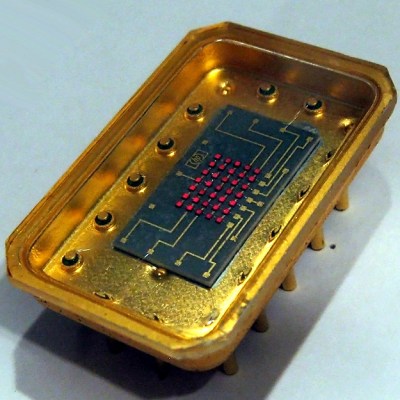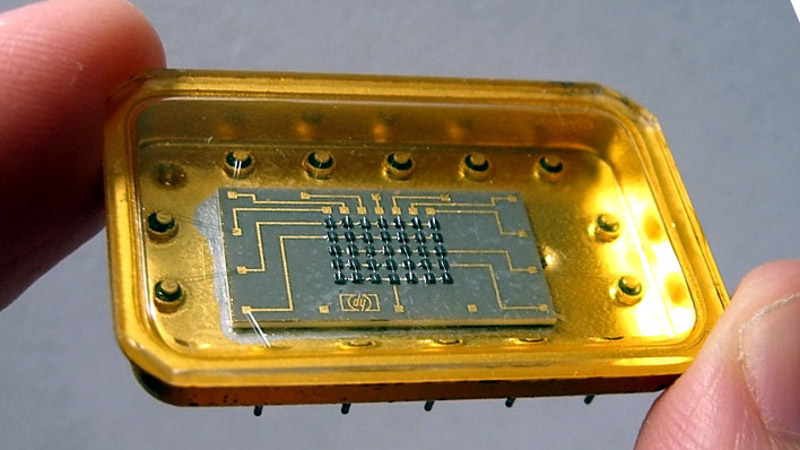Early LED displays came in all sorts of configurations. Because the LED was fairly new technology, all kinds of ideas were getting tried, and with all that work there was plenty of opportunity for hardware that didn’t make the cut to fall into obscurity. That’s exactly what happened to the Hewlett-Packard 5082-7002, a 5×7 LED matrix display with something many of its brethren didn’t: an oversized gold tub to sit in.
 It doesn’t seem that these displays were ever used in any actual products, and its origins are a mystery, but the device itself was nevertheless assigned an HP part number. Beyond that, not much is known about them, but [Industrial Alchemy] reminds us that many early LED devices were poorly documented and never produced in any real quantities. They became forgotten hardware, waiting to be rediscovered.
It doesn’t seem that these displays were ever used in any actual products, and its origins are a mystery, but the device itself was nevertheless assigned an HP part number. Beyond that, not much is known about them, but [Industrial Alchemy] reminds us that many early LED devices were poorly documented and never produced in any real quantities. They became forgotten hardware, waiting to be rediscovered.
The 5082-7002 has a oversized gold tub that makes the 5×7 LED matrix mounted inside look puny by comparison, and reading any display made from these units would be difficult because the large size of the device would mean a lot of empty space between each character or digit. But it’s definitely got a striking look to it, no doubt about that.
What’s neat is that the 5802-7002 actually showed up in a video we featured with a look back at cool old LED technology. If you would like to (briefly) see the HP 5802-7002 a bit closer under a microscope, here is a link to the video, cued to 2:19.
















They must have intended to have a bubble magnifier on these, then readability in a row would have been better. It reminds me of the bubble digit era.
Some of the early matrix LED’s, particularly the semi-smart or smart displays, were REALLY expensive. I have some made of glass bonded to ceramic, 7×5 x 4 digit LED’s that are semi-smart 12 pin DIPs, require column drivers (they have internal shift registers) and they were daylight-readable (possibly for use in aircraft or military). Who knows what they cost new. I’ve had them for about 20 years looking for projects. I’ve only used a few. They get seriously hot in operation and by today’s standards were not very efficient.
When you are building retro-ish equipment, there is a subtle color difference between modern, high efficiency LED’s and the old 1970’s red LED’s. When Oscar designed the PiDP11, I think that he managed to find the old types for kits.
Well, Mr. Bond, how do you like my gold plated LEDs?
No one in the world has them.
But with them in my underground control center, I will soon Rule The World!
But a lot of stuff was ceramic, and gold plated, until they realized they could get by with less.
About 1974 I got a bunch of 747s, dual 741s, in ceramic package, and maybe the pins were gold plated. They weren’t that old then, though I suppose these had been intended for “industrial” use. Around that time I’d get 7400 series TTL in ceramic packages, surplus.
The shift to plastic, and as little gold as possible, coincided with ICs really taking off.
So true, the move from ceramic and gold to plastic and lead definitely brought the price down to the masses.
This proves the evolution of technologies: to be affordable and mainstream, you need to cut down heavily on raw material cost: recyclability isn’t even considered. (isn’t USA still not following RoHS/Reach, excluding California?)
Unless your state requires it it’s still optional. The company I work for adopted it immediately even though we haven’t offered any products with lead in it since the late 60s. Didn’t do anything other than scream we are compliant. I swear there is an ROHS sticker on everything in the building, it’s like they gave the maintenance guy a reel of them and said go wild.
One of my electronics instructors told us of a series of chips made by TI.
The leads were silver plated. Field servicemen were told to carry silver polish, polishing cloths, and toothbrushes if equipment was experiencing intermittent failures. (For ICs that were socketed).
No NSN on it? Somebody had a specific use for that.
Perhaps this LED array was meant for some other app, not a character display. My guess is that it was to live behind some sort of optics. It reminds me of a military system I once worked on of about the same vintage. Where a row of IR sensitive diodes was mapped to a row of LED’s. When combined with a scanning mirror the setup made a nice infrared camera at TV resolution.